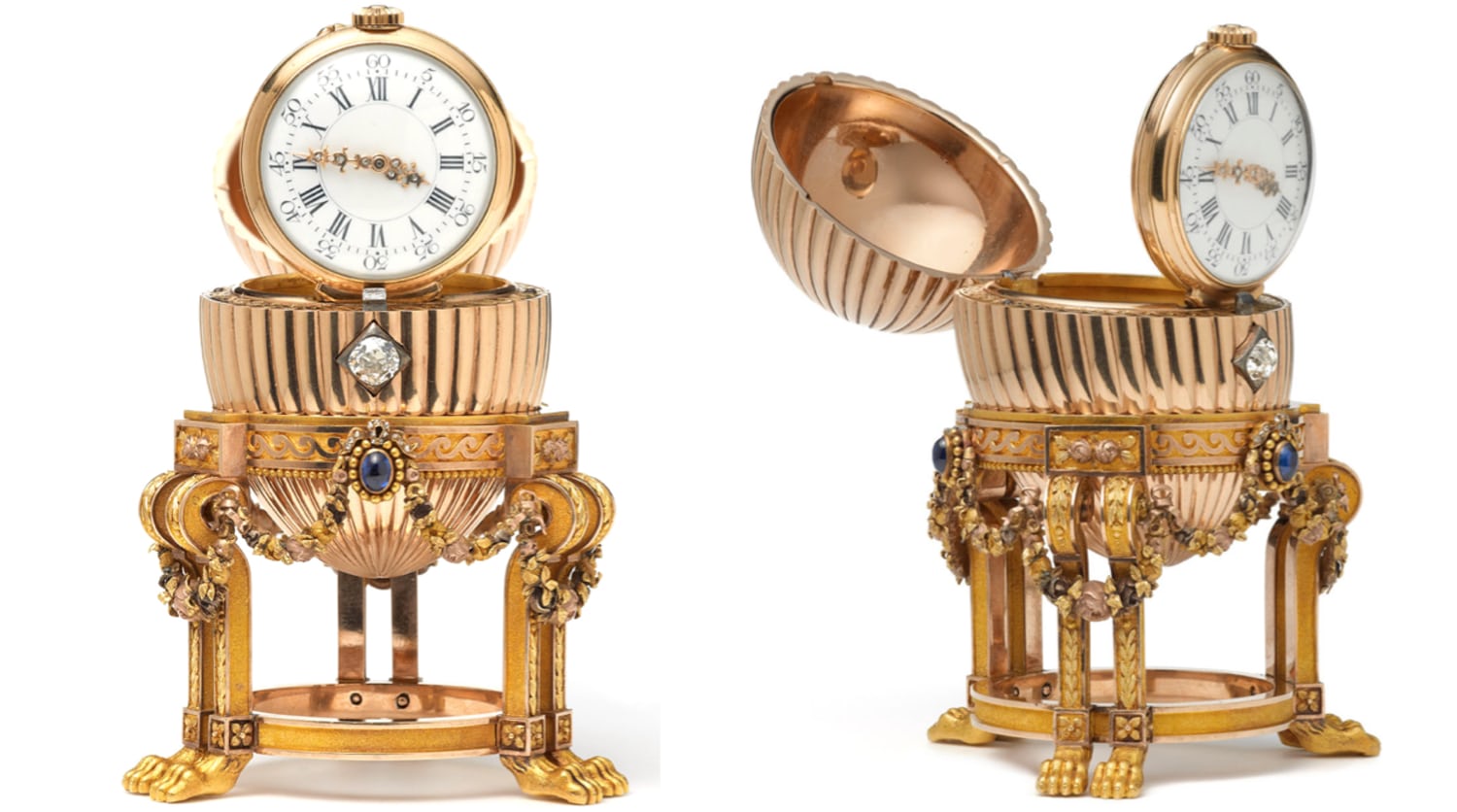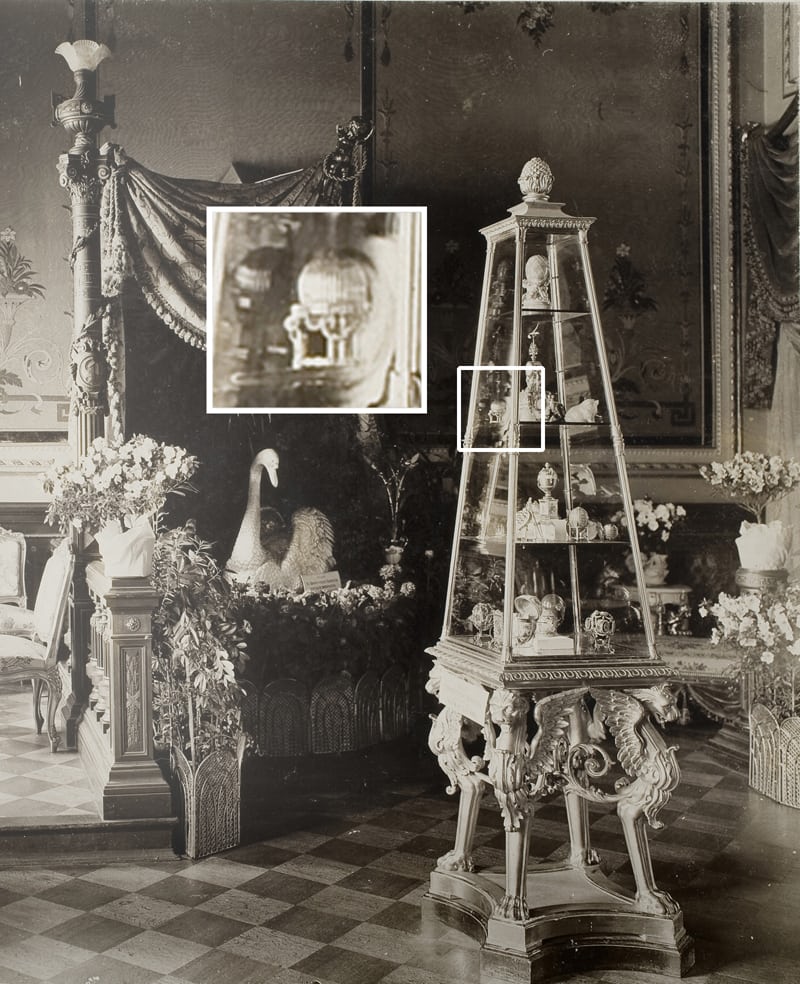First up, the watch site Hodinkee, March 2014 with a typical version of the tale:

In one of those stunning stories only made possible by the Internet, in 2012 a man turned to Google to search for "Vacheron & Constantin" and "egg" to find that the jewel-encrusted gold egg housing a Vacheron watch he purchased for $13,302 in the early 2000s at a Midwestern flea market was in fact an 1887 birthday gift for Tsar Alexander III from Peter Carl Fabergé. It has now sold privately for millions, likely making it the most expensive timepiece on earth.
The unnamed individual stumbled on a 2011 Telegraph article entitled "Is this £20 million nest-egg on your mantelpiece?" The egg was the third of 54 Fabergé eggs owned by the Russian royal family and had been lost since 1922. It is recorded that in 1922 this egg was transferred from the Kremlin Armoury, which had confiscated the eggs in 1917 when the Tsar was overthrown, to the special plenipotentiary of the Council of People's Commissars, Ivan Gavrilovich Chinariov. Beyond the written records, a 1902 photograph of the egg on exhibition in St. Petersburg also survived.

Photograph of a 1902 exhibition in St. Petersburg featuring the egg
Two Fabergé experts, Vincent and Anna Palmade, found the catalog from a 1964 auction by Parke Bernet (an auction house later acquired by Sotheby's) and seeing the photograph they were able to identify an egg that sold for $2,450 as the missing Fabergé egg. We will probably never know how it ended up leaving the USSR and making it to the US, but we imagine it must be a pretty interesting story....MUCH MOREHodinkee is a pretty influential site in the watch world so I'm guessing the story in its broad outlines is true. Someone, who remains unknown, purported to find one of the "lost" Fabergé eggs in a flea market where neither the seller nor he recognized what it might be.
Now we bring in the British jeweler Wartski who have a long history of purveying Fabergé and other goodies (they provided liquidity to Russian aristos fleeing the Bolshies).
The Lost Third Imperial Easter Egg
Given by Alexander III Emperor and Autocrat of all the Russias to
Empress Marie Feodorovna for Easter 1887.
The jewelled and ridged
yellow gold Egg stands on its original tripod pedestal, which has chased
lion paw feet and is encircled by coloured gold garlands suspended from
cabochon blue sapphires topped with rose diamond set bows.
It contains a surprise of a
lady’s watch by Vacheron Constantin, with a white enamel dial and
openwork diamond set gold hands. The watch has been taken from its case
to be mounted in the Egg and is hinged, allowing it to stand upright.
Made in the workshop of Fabergé’s Chief-Jeweller:
August Holmström, St. Petersburg, 1886-1887.
Height 8.2 cm.
Fifty Imperial Easter Eggs were delivered by Carl Fabergé to Emperors Alexander III and Nicholas II from 1885 to 1916. The Third Imperial Easter Egg was until its recent rediscovery among the eight lost Imperial Fabergé Eggs. The Egg was exhibited at Wartski in April 2014. It was last shown over 112 years earlier.
There is no doubt the egg is the real deal the questions are the provenance, and why the finder decided to sell in a privately brokered transaction rather than at public auction, to another buyer who chooses to remain anonymous? Even Wartski knows all this is just weird:
“we
doubt everything but this story is so wonderful you couldn’t really make
it up – it is beyond fiction and in the legends of antique dealing,
there is nothing quite like this.”
—Kieran McCarthy quoted by Reuters.
Mr. McCarthy is a director of Wartski and like Cartier's Jules Glaenzer or top o'the heap art dealer Joseph, Baron Duveen, is a pretty smooth salesman.
If interested here is the Fabergé research page for the Third Imperial Egg (1887)
And Mieks' page for much more.
Don't fret if you only turn up a non-imperial.
From a March 29, 2013 post:
Egg Decorating: The Rothschild Fabergé Clock Egg
This is the only non-Imperial egg that we link to, in part because it is one of only three with both an automaton and a clock and partly because it set three auction records, the $18,500,000 realized price makes this the most expensive timepiece, Russian object and Fabergé object ever sold at auction.
This is the only non-Imperial egg that we link to, in part because it is one of only three with both an automaton and a clock and partly because it set three auction records, the $18,500,000 realized price makes this the most expensive timepiece, Russian object and Fabergé object ever sold at auction.

The Cristies lot notes describes the egg as:
A JEWELLED VARI-COLOURED GOLD-MOUNTED AND ENAMELLED EGG ON PLINTH, INCORPORATING A CLOCK AND AN AUTOMATON
Lot Notes
This previously unrecorded Fabergé egg is known from the codicil to her will quoted above to have been given to Germaine Alice Halphen on her engagement to Baron Edouard de Rothschild in Paris, and married in 1905. It was a gift from Edouard's elder sister Béatrice (also known as Béatrix) Ephrussi, née de Rothschild, and has remained in the recipient's family until now.